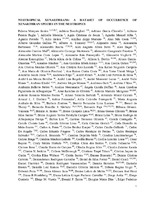Neotropical xenarthrans : a dataset of occurrence of xenarthran species in the neotropics
Date
2019-07-01Author
Marques Santos, Paloma
Bocchiglieri, Adriana
Garcia Chiarello, Adriano
Pereira Paglia, Adriano
Moreira, Adryelle
Abba, Agustin Manuel
Gatica, Ailin
Ochoa, Ana Cecilia
De Angelo, Carlos Daniel
Tellaeche, Cintia Gisele
Varela, Diego Martin
Vanderhoeven, Ezequiel Andrés
Caruso, María Flavia
Arrabal, Juan Pablo
Iezzi, María Eugenia
Di Bitetti, Mario Santiago
Cruz, Paula Andrea
Reppucci, Juan Ignacio
Benito Santamaria, Silvia
Quiroga, Verónica Andrea
Di Blanco, Yamil Edgardo
Marás, Gustavo Arnaldo
Camino, Micaela
Perovic, Pablo Gastón
Martínez Pardo, Julia
Costa, Sebastián Andrés
Pinheiro, Fabiana
Volkmer de Castilho, Pedro
Bercê, William
Camara Assis, Julia
Alves Eigenheer, Milene
Chinem, Simonne
Honda, Laura K.
Bergallo, Helena de Godoy
Alberici, Vinicius
Wallace, Robert
Ribeiro, Milton Cezar
Galetti, Mauro
Metadata
Show full item recordAbstract
Xenarthrans -anteaters, sloths, and armadillos- have essential functions for ecosystem maintenance, such as insect control and nutrient cycling, playing key roles as ecosystem engineers. Because of habitat loss and fragmentation, hunting pressure, and conflicts with domestic dogs, these species have been threatened locally, regionally, or even across their full distribution ranges. The Neotropics harbor 21 species of armadillos, 10 anteaters, and 6 sloths. Our data set includes the families Chlamyphoridae (13), Dasypodidae (7), Myrmecophagidae (3), Bradypodidae (4), and Megalonychidae (2). We have no occurrence data on Dasypus pilosus (Dasypodidae). Regarding Cyclopedidae, until recently, only one species was recognized, but new genetic studies have revealed that the group is represented by seven species. In this data paper, we compiled a total of 42,528 records of 31 species, represented by occurrence and quantitative data, totaling 24,847 unique georeferenced records. The geographic range is from the southern United States, Mexico, and Caribbean countries at the northern portion of the Neotropics, to the austral distribution in Argentina, Paraguay, Chile, and Uruguay. Regarding anteaters, Myrmecophaga tridactyla has the most records (n = 5,941), and Cyclopes sp. Have the fewest (n = 240). The armadillo species with the most data is Dasypus novemcinctus (n = 11,588), and the fewest data are recorded for Calyptophractus retusus (n = 33). With regard to sloth species, Bradypus variegatus has the most records (n = 962), and Bradypus pygmaeus has the fewest (n = 12). Our main objective with Neotropical Xenarthrans is to make occurrence and quantitative data available to facilitate more ecological research, particularly if we integrate the xenarthran data with other data sets of Neotropical Series that will become.
Collections
The following license files are associated with this item:




